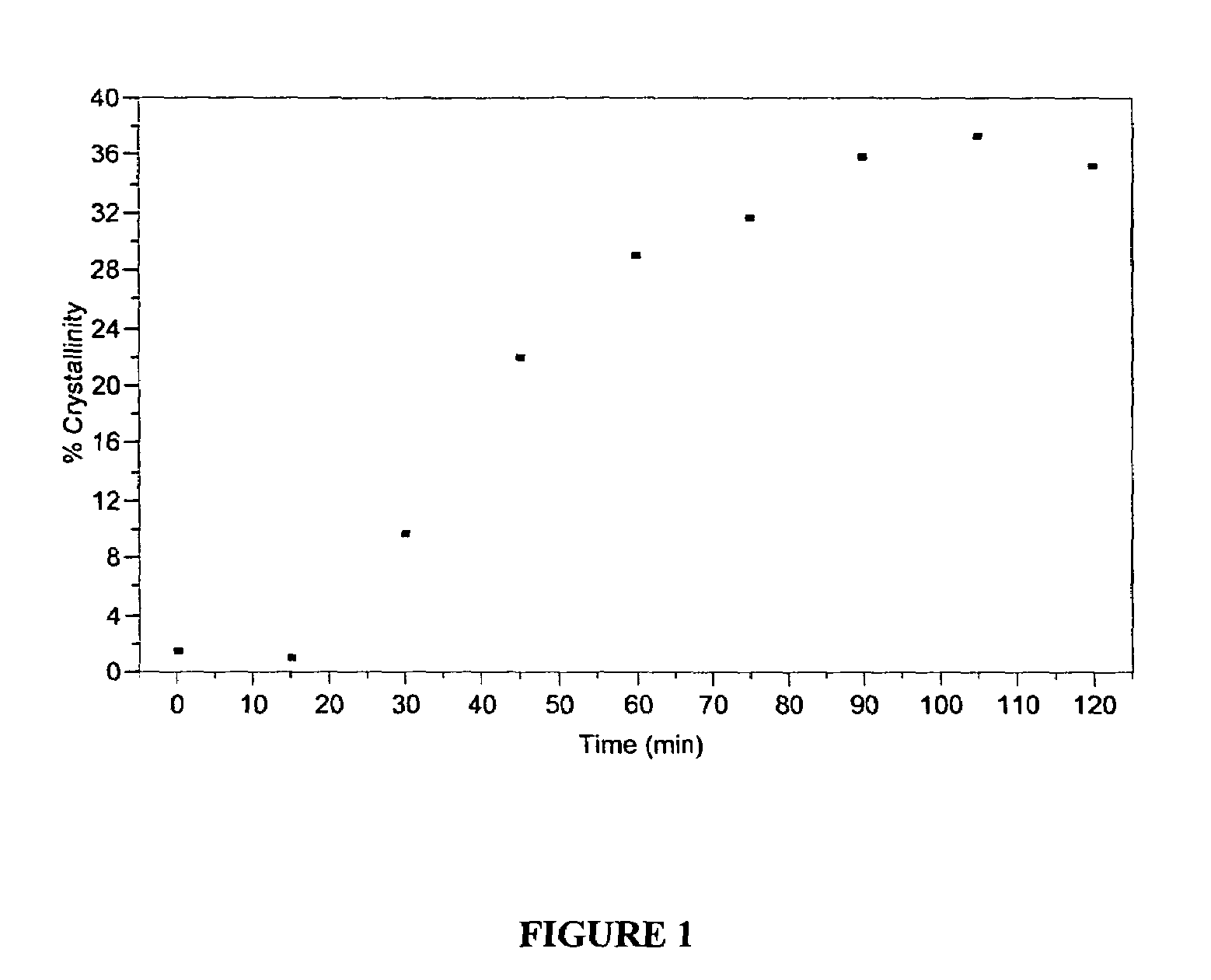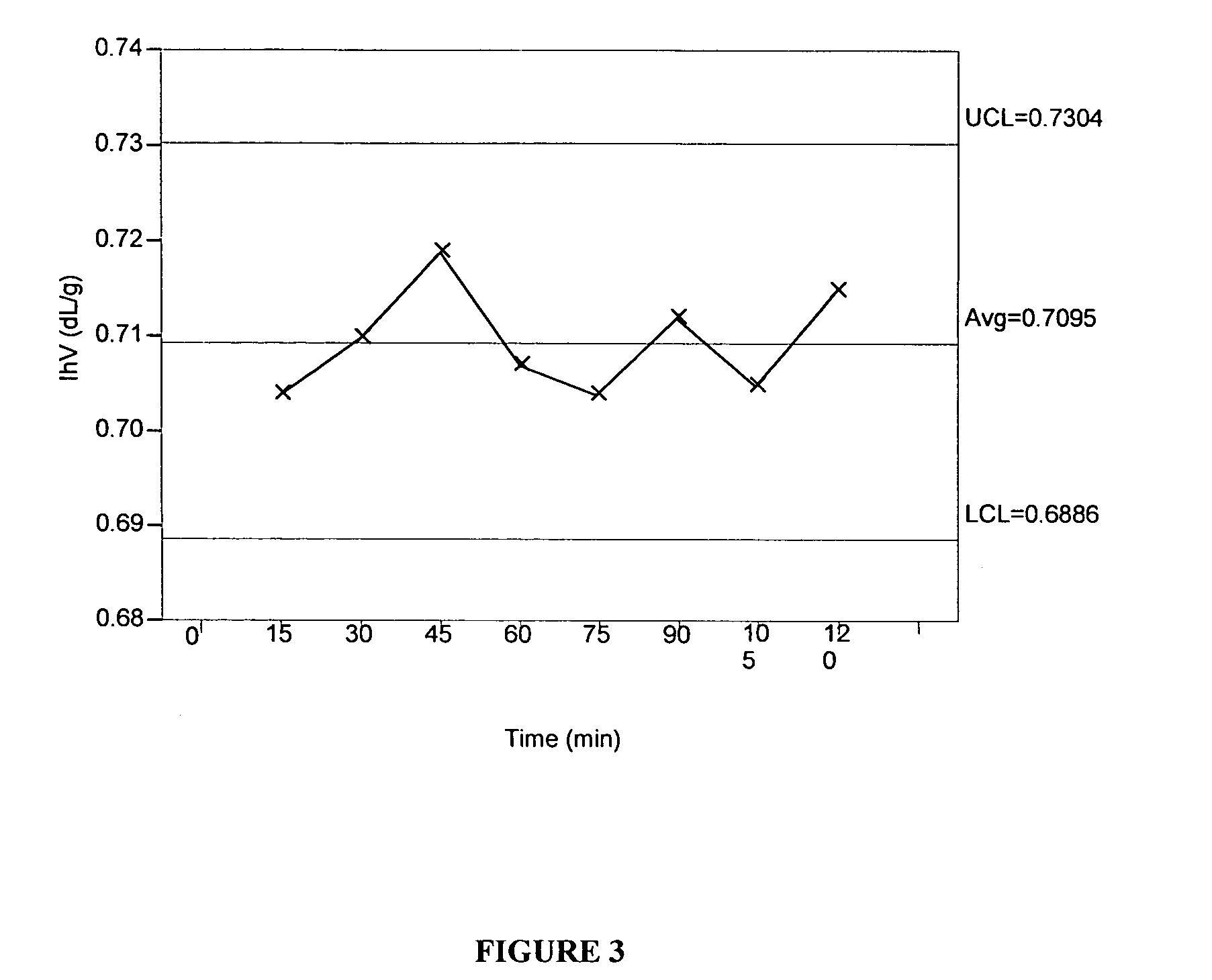Thermal crystallization of polyester pellets in liquid
a technology of polyester pellets and liquid medium, which is applied in the direction of solvent extraction, liquid displacement, separation processes, etc., can solve the problems of large quantities of gas, high temperature of polyester pellets, and high thermal transfer rate of polyester pellets, so as to reduce equipment costs and energy saving
- Summary
- Abstract
- Description
- Claims
- Application Information
AI Technical Summary
Benefits of technology
Problems solved by technology
Method used
Image
Examples
example 3
[0196]Three additional experiments were conducted by heating pellets at 140° C. in this Example, 150° C. in Example 4, and 180° C. in Example 5, each according to the following procedure. For the remaining examples, fifty of the pellets used had a weight of about 0.8 g.
[0197]In each of Examples 3, 4, and 5, the crystallization of the pellets was conducted according to the following procedure. An amorphous single pellet having an Ih.V. of 0.80 dL / g and a calculated It.V. of 0.846 dL / g was placed into a PerkinElmer O-ring sealed, stainless steel DSC pan (part # 0319-0218), along with two drops of Millipore water. A circulating silicone oil bath was preheated to the temperature of the experiment. The DSC pan was placed into the hot oil bath and held in the bath for a time stated below in FIG. 4. The DSC pan with the o-ring contained the internal pressure that developed during the heating phase. After the allotted time, the pan was removed from the bath, excess oil was removed quickly w...
example 4
[0200]According to FIG. 7, pellets crystallized in water at 150° C. also achieved a degree of crystallization in excess of 25% in less than two minutes, and also reached around 29% in about two minutes. FIG. 8 shows that pellets crystallized at 2 to 4 minutes exhibited an initial melting temperature by DSC from between about 157 and 178° C. Moreover, the crystallization conditions did not induce molecular weight build up as can be seen from FIG. 9. Per a linear fit of the estimated Ih.V. from GPC data over a 15 min. interval at 150° C., the Ih.V. loss was predicted to be 0.00300 dL / g per minute.
[0201]The crystallization in water at 150° C. was replicated and tested for crystallinity by DSC and in addition, crystallinity was calculated from the density of the pellets. According to FIG. 10, pellets crystallized in water at 150° C. also achieved a degree of crystallization in excess of 25% in less than two minutes, and also reached around 28.5% in about two minutes. A gradient tube den...
example 5
[0204]At 180° C., crystallization was almost immediate as shown in FIG. 17. Within a minute or less, primary crystallization was obtained to a degree of crystallization at a 30% or more value. Pellets crystallized at 125° C., 140° C. and 150° C. exhibited initial melting points about 20 to 25° higher than their corresponding crystallization temperatures. However, as can be seen from FIG. 18, the lower melting temperature was between 212 to 216° C. for pellets crystallized longer than 2 minutes, representing a 30–35° C. increase over the crystallization temperature of 180° C. As shown in FIG. 19, a linear fit of the estimated Ih.V. data over a 15 min. interval at 180° C. predicted the Ih.V. loss to be 0.01486 dL / g per minute. Accordingly, at higher crystallization temperatures, it is desirable to crystallize for only a short time to avoid significant Ih.V. and It.V. losses.
PUM
| Property | Measurement | Unit |
|---|---|---|
| temperature | aaaaa | aaaaa |
| degree of crystallinity | aaaaa | aaaaa |
| degree of crystallinity | aaaaa | aaaaa |
Abstract
Description
Claims
Application Information
 Login to View More
Login to View More - R&D
- Intellectual Property
- Life Sciences
- Materials
- Tech Scout
- Unparalleled Data Quality
- Higher Quality Content
- 60% Fewer Hallucinations
Browse by: Latest US Patents, China's latest patents, Technical Efficacy Thesaurus, Application Domain, Technology Topic, Popular Technical Reports.
© 2025 PatSnap. All rights reserved.Legal|Privacy policy|Modern Slavery Act Transparency Statement|Sitemap|About US| Contact US: help@patsnap.com



